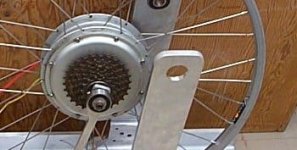amberwolf said:
I guess this would make creating the dropouts a little more "interesting", so that they still prevent axle spin but also allow enough movement of the axle to be measured by the load cell. I was thinking of clamping the axle in the dropouts and then having those dropouts themselves on a bearing pivot that allows it to twist against a load cell, but still remains securely fixed to the bike, although I am not quite sure how to do this yet.
You could try and do it that way too, but the moment your pivot point for the dropout isn't perfectly concentric with the axle, then any other normal force on the wheel would cause a strain on the load cell too. You could decouple from gravity and bumps by placing the dropout pivot directly above or below the axle, but then when you use the rear brakes for instance there would be a resulting force on the cell, and it wouldn't be possible distinguish that from axle torque.
I am hoping that I can use the load cell from a scrapped electronic bathroom scale or similar, to do the readings, although I suppose I'd need to do some experimentation to calibrate it, and that I will have to learn how to do.
Load cells are pretty easy to use and I've done lots of projects with cells that were pulled from cheap $30 digital scales, so that's a fine approach. You cut away whatever onboard electronics are there and hook up the 4-wire strain gauge bridge to an instrmentation amplifier, like this:
http://www.analog.com/en/specialty-amplifiers/instrumentation-amplifiers/ad8236/products/product.html
You can play with the gain of the instrumentation amplifier to get the load cell sensitivity range that you want. So even if the load cell is rated for say 200lb, you can still make it so that you have a full output voltage swing from a 10lb load if that's all your torque sensing dropout would put on it.
You could, although if this is the main goal it would be just as effective and a lot simpler to use a phase current limit on the motor controller rather than trying to measure the motor axle torque directly.
True.

But remember that the typical ebike controller, including all the ones I have, do not have any way to measure phase current--they simply "calculate" it based on battery current, and I'm sure there is a significant enough delay associated with all the processing, combined with inaccuracies in the method, that doing it thru the CA with torque limiting instead would be close enough, or even better.
It could be neat to try, but the controller's calculated phase current limit is still going to be a lot faster acting than the CA measuring torque, then sending a signal back to the controller via the controller's throttle input.
Besides, discovering what torque the motor is actually putting out in various situations (at least at the axle) would be very interesting.
That is for sure! And the most accurate way to so this is to have the axle mounted some way or other concentric in a ball bearing, so that all torque transmission happen through a dedicated arm and all non-torque forces transfer normally to the axle.
-Justin.



